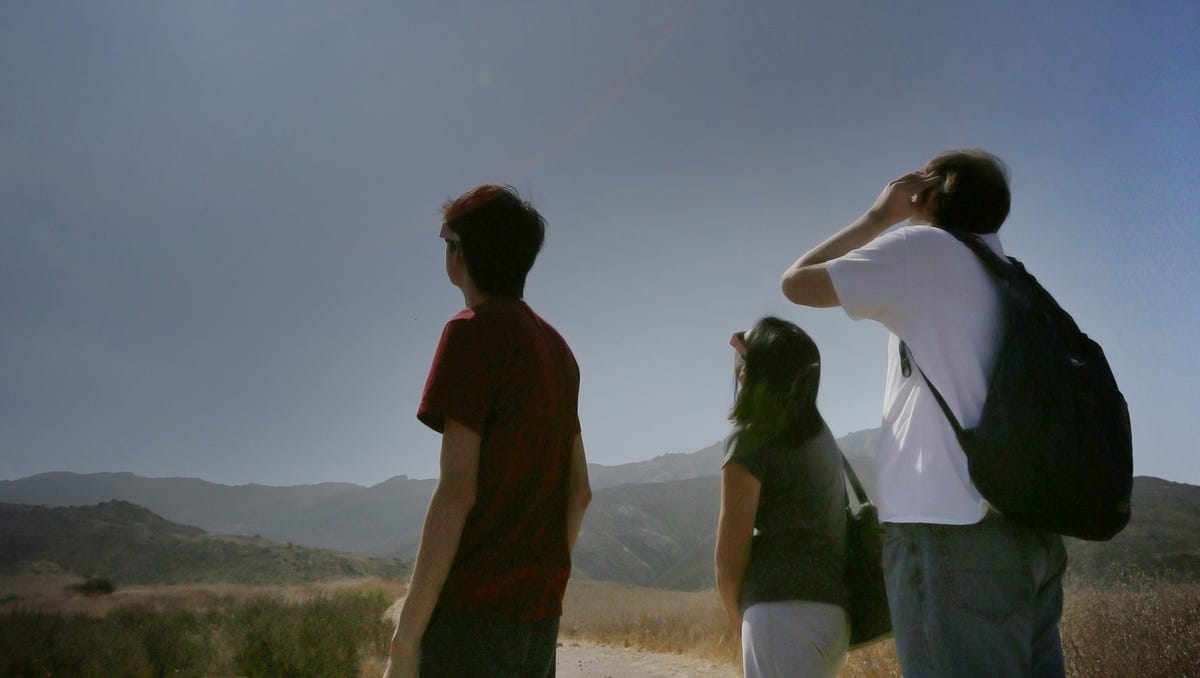California
What to expect for the 2024 total solar eclipse in Southern California

On April 8, millions of Americans will get to see a rare celestial sight — a total solar eclipse crossing over parts of the United States from Texas to Maine.
The moon will pass between the sun and the Earth, but only those in locations where the moon’s shadow completely covers the sun – called the path of totality – will experience the full eclipse. For seconds to minutes, the sky will darken, temperatures drop and wildlife will react to the sudden changes.
While Southern California won’t be in the direct path, the Golden State still has the chance to see a show and witness what experts call an extraordinary phenomenon.
Here’s what to expect.
Can I see the solar eclipse in California?
The first contact in Southern California is expected just after 10 a.m., said Vanessa Alarcon, an astronomical observer at the Griffith Observatory in Los Angeles. She cautioned to wear protective glasses to look directly at the eclipse. People also could project the image of the sun onto another surface using a handmade device or even a kitchen tool.
The peak of eclipse is expected to happen here at 11:12 a.m., Alarcon said. That’s when Southern Californians could see roughly half of the sun blocked by the moon.
What will the solar eclipse look like in Southern California?
A lot may depend on the weather. At first contact, people may notice what appears to be a slice missing from the sun. Around an hour later, the sky likely will get darker as nearly 50% of the sun is blocked.
“You will notice shadows get a little bit weird. They maybe don’t look as crisp,” Alarcon said.
How long will the solar eclipse last?
The entire phenomenon likely could last a couple of hours, she said. After 11:12 a.m., the moon will start to move away from the sun. The eclipse is expected to end by 12:22 p.m.
Is the solar eclipse safe to look at?
The short answer: Not without protective glasses.
NASA officials say it is not safe to look directly at the sun without specialized eye protection. Also, viewing any part of the bright sun through a camera lens, binoculars or a telescope without a special-purpose solar filter will instantly cause severe eye injury, the agency said.
Regular sunglasses let in too much light and won’t work. But people can find ISO-approved solar eclipse glasses at a variety of shops. NASA officials recommend testing them before April 8.
People also can use a pinhole projector to project the sun onto a nearby surface. It can be as simple as punching a pinhole in an index card or using a kitchen colander. With the sun behind you, let the light stream through the tiny hole to see the projected image on another surface.
How often does a solar eclipse happen?
April 8 is the last chance to witness a total eclipse in the continental United States until 2044. While Californians will not be in the path of the total eclipse, they can watch it online. NASA plans to show a live broadcast at nasa.gov/nasatv/ and on its YouTube channel at youtube.com/@NASA.
Have a question about the solar eclipse in Southern California? Email cheri.carlson@vcstar.com and we will try to find the answer.
USA TODAY contributed to this report. Cheri Carlson covers the environment for the Ventura County Star. Reach her at cheri.carlson@vcstar.com or 805-437-0260.

California
California residents flee massive wildfire sparked by burning car

Thousands of Northern California residents were forced to evacuate their homes as a massive wildfire scorched more than 250 square miles. The Park Fire, California’s largest this year, was started by a man who pushed a burning car into a gully.
California
California's billionaire utopia faces a major setback

Silicon Valley’s billionaire-backed plan to turn 60,000 acres into a utopian “city of yesterday” is officially delayed by at least two years. California Forever confirmed on July 22 that its “East Solano Plan” rezoning proposal will not appear on the region’s November election ballot. Instead, the $900 million project will first receive a full, independent environmental impact review while preparing a development agreement with local county supervisors.
Speaking with The New York Times this week, California Democratic state senator John Garamendi said, “The California Forever pipe dream is in a permanent deep freeze.”
First unveiled in August 2023 after years of stealth land purchases just outside San Francisco, organizers bill the 60,000 acre East Solano Plan as a multistep campaign to build “one of the most walkable and sustainable [towns] in the United States.” Concept art on California Forever’s website depicts idyllic pedestrian squares and solar farms, with lofty promises to bring hundreds of thousands of jobs to the area along with “novel methods of design, construction, and governance,” according to a previous profile. Overseen by former Goldman Sachs trader Jan Sramek, California Forever received financial backing from wealthy venture capitalists including LinkedIn’s co-founder Reid Hoffman and Lauren Powell Jobs, billionaire philanthropist and widow of Steve Jobs.
[ California’s billionaire utopia may not be as eco-friendly as advertised.]
But from the start, locals, environmental advocates, and politicians pushed back against the East Solano Plan. By November 2023, news broke that California Forever’s parent company previously sued a group of locals for $510 billion, citing antitrust violations after the defendants refused to sell their land (the locals later agreed to sell for $18,000 per acre). Meanwhile, state representatives voiced security concerns about the proposed city’s proximity to the nearby Travis Air Force Base.
Last month, the accredited Solano Land Trust announced its opposition to the plan, citing what it believed would be a “detrimental impact” to the region’s “water resources, air quality, traffic, farmland, and natural environment.” The land trust also alleged California Forever backers misled the public by describing much of the area as “non-prime farmland” with “low quality soils.” In reality, the Solano Land Trust explained that the “sensitive habitat… home to rare and endangered plants and animals” includes some of the state’s most water-efficient farmland.
In this week’s announcement, Sramek claims a recent poll conducted by California Forever indicated 65 percent of East Solano residents “support development of good paying jobs, more affordable homes, and clean energy,” while noting that “most voters are also asking for a full environmental impact report to be completed first.”
“The idea of building a new community and economic opportunity in eastern Solano seemed impossible on the surface,” Sramek wrote to Popular Science last year. “But after spending a lot of time learning about the community, which I now call home, I became convinced that with thoughtful design, the right long-term patient investors, and strong partnerships… we can create a new community.”
California
Tech Jobs Keep Moving Out of California. Don’t Panic Yet.

It has been a weird four years for California’s technology sector. It boomed early in the Covid-19 pandemic as people in the US and around the world geared up for remote work and directed their spending to online services (games, streaming, spin classes, etc.) they could consume without leaving home. But that rise in remote work, combined with highest-in-the-nation real estate costs, strict pandemic rules and other factors, also led to something of an exodus from the state’s coastal cities, with high-profile departures of tech leaders in 2020 and 2021 and even occasional claims that the San Francisco Bay Area’s reign as global tech capital was ending.
A few high-profile departures are still taking place, with Elon Musk announcing this month that he will be moving the headquarters of two more of his companies — X, the former Twitter, and SpaceX — from California to Texas, where he moved Tesla Inc.’s headquarters in 2021. But there have also been stories of tech leaders returning and San Francisco beginning a resurgence, with the boom in generative artificial intelligence — the biggest story in tech now — very much concentrated around the San Francisco Bay. My fellow Bloomberg Opinion columnist Conor Sen thinks it might even be a good time to buy some slightly marked-down San Francisco real estate.
-

 World1 week ago
World1 week agoOne dead after car crashes into restaurant in Paris
-

 Midwest1 week ago
Midwest1 week agoMichigan rep posts video response to Stephen Colbert's joke about his RNC speech: 'Touché'
-

 News1 week ago
News1 week agoVideo: Young Republicans on Why Their Party Isn’t Reaching Gen Z (And What They Can Do About It)
-

 Movie Reviews1 week ago
Movie Reviews1 week agoMovie Review: A new generation drives into the storm in rousing ‘Twisters’
-

 News1 week ago
News1 week agoIn Milwaukee, Black Voters Struggle to Find a Home With Either Party
-

 Politics1 week ago
Politics1 week agoFox News Politics: The Call is Coming from Inside the House
-

 News1 week ago
News1 week agoVideo: J.D. Vance Accepts Vice-Presidential Nomination
-

 World1 week ago
World1 week agoTrump to take RNC stage for first speech since assassination attempt



















